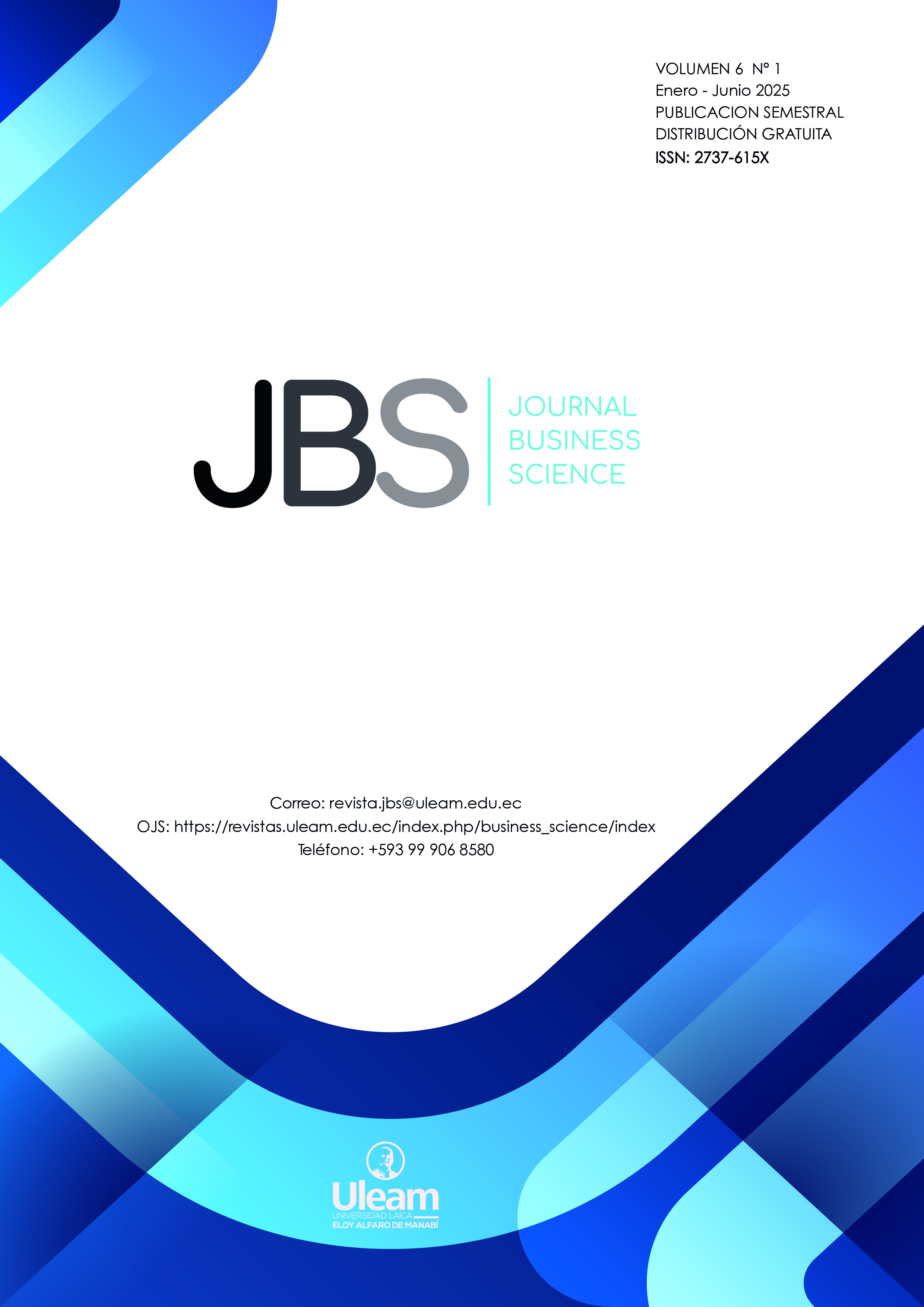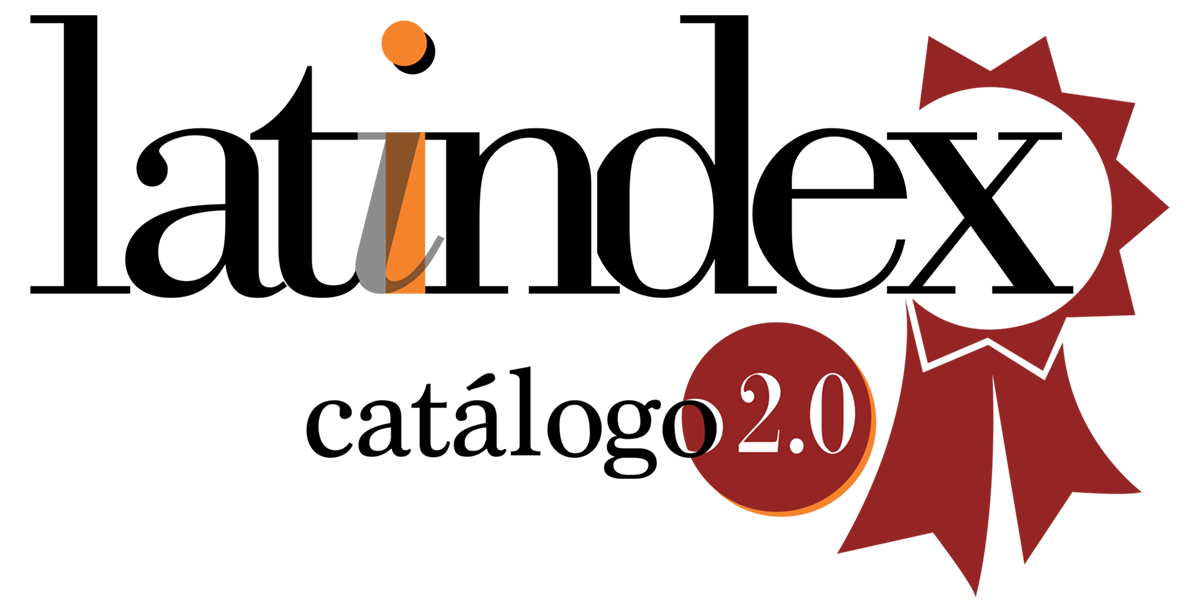Barreras comunicacionales en la adopción del teletrabajo en funciones administrativas de pymes
DOI:
https://doi.org/10.56124/jbs.v6i1.009Palabras clave:
Barreras comunicacionales, teletrabajo, comunicación organizacional, Pymes manufactureras, resistencia al cambio, políticas internasResumen
Este estudio examina las barreras comunicacionales que afectan la adopción del teletrabajo en funciones administrativas de pequeñas y medianas empresas (Pymes) manufactureras del cantón Daule, Ecuador. A través de un enfoque mixto, se identificaron obstáculos clave como la ausencia de políticas claras (90%), el escaso apoyo organizacional percibido (68%) y la comunicación interna deficiente, pese a que el 76% del personal dispone de herramientas digitales. La alta preferencia por el trabajo presencial (68%) evidencia necesidades no satisfechas de interacción y retroalimentación. Los hallazgos indican que la disponibilidad tecnológica no basta para implementar con éxito el teletrabajo. Se requiere fortalecer competencias comunicacionales, establecer protocolos formales e impulsar un liderazgo remoto eficaz. La comunicación organizacional emerge como un habilitador estratégico para la transformación digital, y su fortalecimiento resulta esencial para superar barreras estructurales y culturales, mejorando así la resiliencia y competitividad de las Pymes en entornos laborales virtuales.
PALABRAS CLAVES: Barreras comunicacionales, teletrabajo, comunicación organizacional, Pymes manufactureras, resistencia al cambio, políticas internas.
Citas
Adair, W. L., Buchan, N. R., Chen, X.-P. & Liu, L. A. (2024). What’s not being said when communications are virtual? In Springer Series in Emerging Cultural Perspectives in Work, Organizational, and Personnel Studies (pp. 123–137). Springer Nature Switzerland. https://doi.org/10.1007/978-3-031-53645-8_9
Ajibi, D. & Abuanza, R. (2024). Remote workforce dynamics: Challenges and strategies for virtual collabora-tion. Journal of Business Research and Practice, 17(1), 25–42.
Ajibi, Q. & Abuanza, A. (2024). Analysis of the impact of remote work on productivity and job satisfaction in multinational companies: Application to Saudi Aramco. International Journal of Financial, Adminis-trative, and Economic Sciences, 3(10), 1201–1234. https://doi.org/10.59992/ijfaes.2024.v3n10p31
Alba, C. & Chiatchoua, C. (2022). Remote work legislation and its impact on SMEs post-COVID. International Journal of Management Studies, 48(2), 34–49.
Almeida, F., Rodrigues, H. & Freitas, P. (2024). “No need to dress to impress”: Evidence on teleworking during and after the pandemic – A systematic review. Administrative Sciences, 14(4), 76. https://doi.org/10.3390/admsci14040076
Almeida, L., Rodríguez, M. y Vega, J. (2024). Gestión estratégica de personas en entornos digitales híbridos. Revista Iberoamericana de Administración, 40(1), 22–39.
Anne, A. D., Lambert, E. & Deyganto, K. O. (2024). Effective communication in virtual project teams at Chil-dren Mission Africa: A short communication. Qeios Ltd. https://doi.org/10.32388/fgfjgr
Banco Interamericano de Desarrollo. (2022). Teletrabajo: Qué es y cómo está cambiando el mundo laboral. https://blogs.iadb.org/trabajo/es/teletrabajo-que-es-y-como-esta-cambiando-el-mundo-laboral/
Barrero, J. M., Bloom, N. & Davis, S. J. (2021). Why working from home will stick (NBER Working Paper No. 28731). National Bureau of Economic Research. https://doi.org/10.3386/w28731
Boell, S. K., Campbell, J., Cecez-Kecmanovic, D. & Cheng, J. E. (2013). The transformative nature of tele-work: A review of the literature.
Breevaart, K., Bakker, A. B., Demerouti, E. & Hetland, J. (2016). The measurement of LMX relationships and transformational leadership: Their role in daily work engagement. The Leadership Quarterly, 27(3), 506–517. https://doi.org/10.1016/j.leaqua.2015.12.003
Busu, M. & Gyorgy, A. (2021). Teleworking and business performance: Empirical evidence from SMEs. Eco-nomic Computation and Economic Cybernetics Studies and Research, 55(1), 121–134.
Busu, M. & Gyorgy, A. (2021). The mediating role of the ability to adapt to teleworking to increase the organi-zational performance. Amfiteatru Economic, 23(58), 654. https://doi.org/10.24818/ea/2021/58/654
Canals, C. y Carreras, O. (2020). ¿Cómo afecta el teletrabajo a la sociedad y a nuestro modo de vida? Caixa-Bank Research. https://www.caixabankresearch.com/es/economia-y-mercados/mercado-laboral-y-demografia/como-afecta-teletrabajo-sociedad-y-nuestro-modo
Casey, C. & Richardson, J. (2006). Virtual team interaction: The role of communication and trust. Information Systems Journal, 16(3), 229–253.
Casey, V. & Richardson, I. (2006). Uncovering the reality within virtual software teams. In Proceedings of the 2006 International Workshop on Global Software Development for the Practitioner (pp. 66–72). ACM. https://doi.org/10.1145/1138506.1138523
Código del Trabajo. (2005). https://www.ces.gob.ec/lotaip/2020/Junio/Literal_a2/C%C3%B3digo%20del%20Trabajo.pdf
Contreras, F., Baykal, E. & Abid, G. (2020). E-leadership and teleworking in times of COVID-19 and beyond: What we know and where do we go. Frontiers in Psychology, 11, 590271. https://doi.org/10.3389/fpsyg.2020.590271
Creswell, J. W. y Plano Clark, V. L. (2018). Diseño y desarrollo de investigaciones con métodos mixtos (2.ª ed.). Editorial PAX.
Dambrin, C. (2004). How silent is silent? Tactical aspects of ‘silence’ in organizational change. Journal of Organizational Change Management, 17(4), 370–382.
Dambrin, C. (2004). How does telework influence the manager-employee relationship? International Journal of Human Resources Development and Management, 4(4), 358. https://doi.org/10.1504/ijhrdm.2004.005044
Davison, R. (2006). The cultural barriers to virtual team communication. Communications of the ACM, 49(4), 93–97.
Davison, R. (2006). Virtual work, teams and organisations. Information Technology & People, 19(4). https://doi.org/10.1108/itp.2006.16119daa.001
Eurofound. (2020). Telework and ICT-based mobile work: Flexible working in the digital age. Publications Office of the European Union.
Eurofound. (2021). Right to disconnect: Exploring company practices. Publications Office of the European Union.
Eurofound. (2021). Telework and the right to disconnect. Publications Office of the European Union. https://www.eurofound.europa.eu
Eurofound & International Labour Organization (ILO). (2020). Working anytime, anywhere: The effects on the world of work. Publications Office of the European Union. https://www.eurofound.europa.eu/publications
Fana, M., Milasi, S., Napierala, J., Fernández-Macías, E. & Vázquez, I. G. (2020). Telework, work organisation and job quality during the COVID-19 crisis: A qualitative study (No. 2020/11). JRC Working Papers Series on Labour, Education and Technology.
Fana, M., Tolan, S., Torrejón, S., Urzi Brancati, C. & Fernández-Macías, E. (2020). The COVID confinement measures and EU labour markets. JRC Science for Policy Report.
Fernandez, M. (2021). El teletrabajo en España antes, durante y después del confinamiento domiciliario. Revis-ta Internacional y Comparada de Relaciones laborales y derecho del empleo. https://ejcls.adapt.it/index.php/rlde_adapt/article/view/957
Fuchs, C. & Reichel, A. (2023). Effective communication for relational coordination in remote work: How job characteristics and HR practices shape user–technology interactions. Human Resource Management, 62(4), 511–528. https://doi.org/10.1002/hrm.22161
Fuchs, C. & Reichel, A. (2023). Managing remote collaboration: Technological choices and communication dynamics in SMEs. Journal of Organizational Behavior, 44(2), 115–134.
Gomez, F. (2023). Crear capacidades en un país de oportunidades limitadas: Experiencias en teletrabajo de un grupo de jóvenes de zonas populares de Barquisimeto, Venezuela. Mayéutica: Revista científica de humanidades y artes. http://repositorio.ucsg.edu.ec/bitstream/3317/21995/1/T-UCSG-PRE-ECO-ADM-703.pdf#page=64&zoom=100,150,794
Hernández Sampieri, R. y Mendoza, C. (2018). Metodología de la investigación. Las rutas cuantitativa, cuali-tativa y mixta. McGraw-Hill Education. https://virtual.cuautitlan.unam.mx/rudics/?p=2612
Hernández Sampieri, R., Fernández Collado, C. y Baptista Lucio, P. (2014). Metodología de la investigación. McGraw-Hill / Interamericana.
International Labour Organization (ILO). (2021). Working from home: From invisibility to decent work. https://www.ilo.org/global/publications/books/WCMS_765806/lang--en/index.htm
Kniffin, K. M., Narayanan, J., Anseel, F., et al. (2021). COVID-19 and the workplace: Implications, issues, and insights for future research and action. American Psychologist, 76(1), 63–77. https://doi.org/10.1037/amp0000716
Kunze, F., Hampel, K. & Zimmermann, S. (2020). Homeoffice in der Corona-Krise: Eine nachhaltige Trans-formation der Arbeitswelt?
Kunze, F., Hampel, K. & Zimmermann, S. (2020). Leadership in times of crisis: A framework for remote work success. Journal of Leadership & Organizational Studies, 27(3), 244–257.
Lagutina, I. V. (2022). Teleworking “is here to stay”? Juris Europensis Scientia, (2), 46–49. https://doi.org/10.32837/chern.v0i2.344
Ley Orgánica del Servicio Público. (2010). https://www.oas.org/juridico/pdfs/mesicic5_ecu_ane_mdt_4.3_ley_org_ser_p%C3%BAb.pdf
Lohikoski, P., Bauman, J. & Mäkinen, R. (2015). Communication challenges in multinational virtual teams: Case study evidence. Team Performance Management, 21(3/4), 171–188.
Lohikoski, P., Kujala, J., Haapasalo, H., Härkönen, J. & Mursula, L. A. (2015). Managing barriers of virtual communication in global new product development projects. International Journal of Networking and Virtual Organisations, 15(4), 277. https://doi.org/10.1504/ijnvo.2015.073848
Managing Remote Teams in Organisations: Best Practices for Effective Collaboration and Communication. (2023). PsychologyandEducation, 55(1). https://doi.org/10.48047/pne.2018.55.1.16
Martínez Mediano, C. (2014). Técnicas e instrumentos de recogida y análisis de datos. Universidad Nacional de Educación a Distancia. https://books.google.com.pe/books?id=iiTHAwAAQBAJ
Martínez Mediano, C. (2014). Diseños de investigación en educación y psicología. UNED.
Mazzei, A. (2014). Internal communication for employee enablement: Strategies in times of crisis. Corporate Communications: An International Journal, 19(3), 382–397.
Messenger, J. C. (2019). Telework in the 21st Century. Edward Elgar Publishing.
Ministerio de Trabajo. (2021). Trabajos híbridos y su aplicación en Ecuador. https://www.trabajo.gob.ec/wp-content/uploads/2024/01/24.mdt-diet-0082-2021_estudio_trabajos_hibridos-signed-signed-1.pdf
Mohanty, S. (2014). Building trust in virtual teams: Role of communication. International Journal of Business and Management, 9(5), 43–55.
Müggenburg, H. y Pérez, M. (2018). Diseños de investigación en ciencias sociales. Fondo de Cultura Económi-ca.
Müggenburg, M. y Pérez, I. (2018). Tipos de estudio en el enfoque de investigación cuantitativa. https://www.researchgate.net/publication/330605968_Tipos_de_estudio_en_el_enfoque_de_investigacion_cuantitativa
Municipalidad de Guayaquil. (2020). Alcaldía de Guayaquil. https://guayaquil.gob.ec/divisi%C3%B3n
OECD. (2021). Teleworking after COVID-19: Where do we go from here? https://www.oecd.org/coronavirus
OECD. (2021). Teleworking in the post-COVID world: A review of best practices. https://www.oecd.org/publications
Olson, M. H. (1983). Remote office work: Changing work patterns in space and time. Communications of the ACM, 26(3), 182–187.
Organización Internacional del Trabajo (OIT). (2020). El teletrabajo durante la pandemia de COVID-19 y después de ella.
Rodríguez, D. M. A. y García, A. M. G. (2016). El teletrabajo: la asertividad como estrategia de comunicación en el mundo laboral. Revista Reflexiones y Saberes, (4), 48–55.
Rodríguez, M. T. y García, L. R. (2016). La comunicación asertiva en las organizaciones: Herramientas para el liderazgo efectivo. Revista Comunicarte, 10(1), 45–59.
Sahal, A. M., Abdullahi, M. O., Mohamud, I. H. & Elmi, A. A. (2024). Remote work and telecommuting: A comprehensive bibliometric analysis of HRM practices post-pandemic. International Journal of Elec-trical and Electronics Engineering, 11(11), 312–325. https://doi.org/10.14445/23488379/ijeee-v11i11p130
Sahal, R., Salinas, G. & Torres, A. (2024). Digital transformation and hybrid work in SMEs: Lessons post-pandemic. Journal of Small Business and Enterprise Development, 31(1), 101–119.
Shin, Y. (2002). Beyond interaction: The relational components of computer-mediated communication. Orga-nization Science, 13(3), 324–340.
Silvestre, I. y Huamán, C. (2019). Pasos para elaborar la investigación y la redacción de la tesis universitaria. https://alicia.concytec.gob.pe/vufind/Record/UTEA_0265e70f66be6ec7cb5c597f61aa09c4/Details
Stranzl, J., Ruppel, C. & Einwiller, S. (2024). Staying emotionally connected while being physically apart – Exploring what teleworkers need to stay committed and how internal communication can contribute. Journal of Communication Management, 28(2), 272–293. https://doi.org/10.1108/jcom-02-2023-0023
Stranzl, J., Schwarz, G. & Meier, K. (2024). Internal communication and emotional connection in remote teams: Insights from post-pandemic organizational behavior. Journal of Communication Management, 28(1), 12–30.
Stranzl, J., Schwarz, G. & Meier, K. (2024). Remote work and internal communication: Lessons from the hy-brid model. Journal of Communication Management, 28(1), 21–38.
Swart, J., Rees, C. & Hodgkinson, G. (2022). Trust and performance in virtual teams: What makes it work? Group & Organization Management, 47(1), 85–117.
Swart, K., Bond-Barnard, T. & Chugh, R. (2022). Challenges and critical success factors of digital communica-tion, collaboration and knowledge sharing in project management virtual teams: A review. Interna-tional Journal of Information Systems and Project Management, 10(4), 59–75. https://doi.org/10.12821/ijispm100404
Tapasco, O. y Giraldo, J. (2020). Asociación entre posturas administrativas de directivos y su disposición hacia la adopción del teletrabajo. Información Tecnológica. https://www.scielo.cl/scielo.php?script=sci_arttext&pid=S0718-07642020000100149
Tapia-Alba, J. A. y Chiatchoua, C. (2022). Teletrabajo como evolución de las relaciones económicas y de pro-ducción: Una mirada hacia 2030. Revista Gestión de las Personas y Tecnología, 15(45), 66–93.
Teixeira, L. (2024). Building digital culture in hybrid organizations: Communication, inclusion, and flexibility. Journal of Organizational Effectiveness, 11(2), 45–67.
Teixeira, L. (2024). Reinventing organizational culture for hybrid teams: Leadership, inclusion and perfor-mance. Journal of Organizational Effectiveness, 11(2), 45–67.
Teixeira, R. M. (2024). Teletrabalho pós-pandemia: Impactos e perspectivas. Revista FT, 29(140), 59–60. https://doi.org/10.69849/revistaft/ni10202411171459
Descargas
Publicado
Cómo citar
Número
Sección
Licencia
Derechos de autor 2025 Karol Gabriel Bayona Moncayo , Jorge Enrique Navarrete Macías, Wellington Abel Molina Andrade

Esta obra está bajo una licencia internacional Creative Commons Atribución-NoComercial-CompartirIgual 4.0.




















